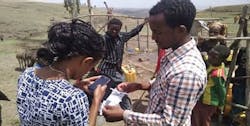Testing: Simple & Reliable
Working in many of the poorest regions of the world, non-governmental organizations (NGOs) and their partners are mindful, now more than ever, of the need to make their work sustainable. Part of that goal is using testing processes that are relatively inexpensive, not just because of NGOs’ limited budgets under grants or other fundraising, but also because communities need such methods to continue maintenance and governance of the systems after the construction phase.
In two countries where members of the Millennium Water Alliance (MWA) have significant programs—Nicaragua and Ethiopia—the Compartment Bag Test (CBT) has been used to test for E. coli on site.
Nicaragua Application
In Nicaragua, MWA and WaterAid Nicaragua (affiliated with WaterAid America, an MWA member) measured supply service levels in household rainwater harvesting systems and other water sources in the municipality of Puerto Cabezas. The goal was to better understand the quality of service for different water sources as well as how people perceive the different sources. One challenge was water quality testing needed to be done in remote locations without access to a lab.
The research was a collaboration between WaterAid Nicaragua, MWA and the University of Leeds (U.K.). It was financed by the FEMSA Foundation, Catalan Cooperation Fund for Development and Rotary Intl.
MWA and WaterAid decided to try the CBT, produced by Aguagenx of Chapel Hill, N.C. The researchers tested for turbidity and pH in addition to E. coli. They analyzed samples from various water sources in the dry and rainy seasons, monitoring differences between shallow unprotected wells, shallow concrete-lined wells, rooftop rainwater harvesting systems, surface water and a hand pump-equipped borehole.
Researchers found the rooftop rainwater harvesting systems installed by the community with WaterAid Nicaragua and one hand pump-equipped borehole well provided the best and most consistent bacteriological water quality out of the more than 25 water sources available in the community.
“We continued using the CBT because it’s easy to use and to interpret and share the results,” said Daniel W. Smith, who was a program officer for MWA at the time of the research. “Its quantitative data help us build evidence of the advantages and disadvantages of the different types of water supplies that we can help communities develop.”
Smith also believes the CBT’s color-change results are a big help in the field. “The CBT’s positive and negative compartments for E. coli are easy to understand for residents and researchers alike,” he said. “In our Nicaragua research, the water sources with the lowest concentrations of fecal indicators were quickly apparent using the CBT. It was great to get results so fast because we could share them locally in real time, which helped the water sampling be relevant for the local WASH [water, sanitation and hygiene] initiative as well as the research.
“WaterAid’s work in Nicaragua is very far from paved roads and any water quality laboratory,” he added. “We appreciate lightweight and portability for reaching those locations.”
After using the CBT for a relatively modest number of samples in Nicaragua, MWA scaled up to use them with hundreds of samples as part of a national-scale water quality research project with its partners in Ethiopia.
Ethiopia Application
MWA used CBT in its major ongoing WASH program in Ethiopia, implemented by five MWA members (CARE, Catholic Relief Services, Living Water Intl., WaterAid and World Vision), for a baseline survey and water quality study in its previous and current project areas.
Mussie Tezazu, monitoring and evaluation manager for MWA-Ethiopia, said the testing kit has worked well in many of the remote rural areas of the country where the organization works to improve water and sanitation access.
“It is low-cost and easy to use, for both professionals and para-professionals, with minor orientation or indication,” Tezazu said. “It meets the World Health Organization standard 100-mL volume for water microbiology testing, and it’s easy for data collectors to score and record the results.”
Use in some areas is tricky, however, because of the absence of electricity and because portable incubators are not convenient in all cases. The CBT has required incubation times.
Lisa Hirsh of Aquagenx noted the CBT enables ambient temperature incubation at 25°C and above, works at variable temperatures and does not require constant temperature control in an incubator. If one is testing below 25°C, the samples need to incubate for 48 hours.
Download: Here
